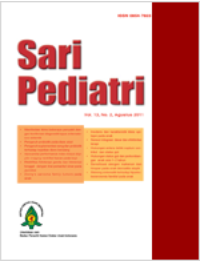Tingkat Pengetahuan, Perilaku, dan Kepatuhan Berobat Orangtua dari Pasien Epilepsi Anak di Medan
Sari
Latar belakang. Beberapa kepustakaan menyatakan, masih kurang pengetahuan orangtua tentang penyakit
epilepsi. Perilaku negatif terhadap anak pasien epilepsi disebabkan karena ketidaktahuan dan kesalahan
pengertian terhadap penyakit epilepsi.
Tujuan. Mengetahui tingkat pengetahuan, perilaku, dan kepatuhan berobat pada orangtua dari anak pasien
epilepsi.
Metode. Penelitian merupakan suatu studi deskriptif terhadap 65 orangtua dan pengasuh dari anak pasien
epilepsi (usia 0-18 tahun) yang datang ke poliklinik neurologi anak RSUP H. Adam Malik Medan, antara
bulan Januari-Maret 2008. Digunakan kuesioner yang terdiri dari 39 pertanyaan yang diisi sendiri oleh
orangtua ataupun pengasuh.
Hasil. Dari 65 orang responden, 89,2% adalah orangtua dari anak pasien epilepsi. Responden (46,2%)
berusia 31-40 tahun, dan 13,8% berpendidikan setingkat universitas. Dari hasil kuesioner yang menilai tingkat
pengetahuan didapat 82,5% pernah mendengar tentang epilepsi, tetapi 92,1% di antaranya menjawab
masih memerlukan informasi lebih tentang epilepsi. Pada 55,6% responden setuju bahwa epilepsi dapat
menyebabkan perubahan perilaku. Mengenai kepatuhan berobat, 79,4% responden secara teratur mendapat
obat anti epilepsi.
Kesimpulan. Meskipun tingkat kepatuhan berobat cukup baik, tetapi sebagian besar orangtua dan pengasuh
dari anak epilepsi pernah mendengar tentang epilepsi tetapi informasi yang didapat masih terbatas. Mereka
membutuhkan tambahan informasi tentang penyakit epilepsi dan pengobatannya. Perlu dilakukan program
edukasi dan penyebaran informasi pada orangtua dari anak pasien epilepsi dan masyarakat di Medan dan
sekitarnya.
Kata Kunci
Teks Lengkap:
PDFReferensi
Sridharan R. Epidemiology of epilepsy. Current Science
; 82:664-70.
Passat J. Kelainan paroksismal. Dalam: Soetomenggolo
TS, Ismael S, penyunting. Neurologi Anak. Edisi kedua.
Jakarta: Ikatan Dokter Anak Indonesia; 1999.h.190-7.
Thornton N, Hamiwka L, Sherman E, Tse E, Blackman
M, Wirrell E. Family function in cognitively normal
children with epilepsy: Impact on competence and
problem behaviors. Epilepsy & Behavior 2008;12:90-5.
Kwong KL, Wong SN, So KT. Parental perception,
worries and needs in children with epilepsy. Acta Paediatr
; 89:593-6.
Trana D, Odermatta P, Singphuoangpheta S, Druet-
Cabanacc M, Preuxc P. Epilepsy in Laos: Knowledge,
attitudes, and practices in the community. Epilepsy &
Behavior 2007; 10:565-70.
Sureka RK, Sureka R. Knowledge, attitude and practices
with regard to epilepsy in rural north-west India. Ann
Indian Acad Neurol 2007;10:160-4.
Winnick S, Lucas DO, Hartman AL, Toll D. How Do
You Improve Compliance? Pediatr 2005;115:e718–24.
Kobau R, Price P. Knowlwdge of epilepsy and familiarity
with this disorder in the U.S. population: results from the
health styles survey. Epilepsia 2003; 44:1449-54.
Mirnics Z, Czikora G, Zavecs T, Halasz P. Changes in
public attitudes toward epilepsy in Hungary: results of
surveys conducted in 1994 and 2000. Epilepsia 2001;
:86-93.
Fong G, Hung A. Public awareness, attitude, and
understanding of epilepsy in Hongkong. Epilepsia 2002;
:311-6.
Aramyan L. Survey of parents of children with epilepsy in
Yerevan, Armenia. Knowledge, attitude, compliance with
treatment (dissertation). Yerevan: American University
of Armenia, 2005.
Jacoby A, Gorry J, Gamble C, Baker GA. Public
knowledge, private grief: a study of public attitudes to
epilepsy in the UK and implications for stigma (thesis).
Liverpool: University of Liverpool, 2001.
Boer HM. Epilepsy and society. Epilepsia 1995; 36Supl
:S8-11.
Fernandez PT, Salgado PCB, Noronha ALA, Barbosa
FD, de Souza EAP, Li LM. Stigma scale of epilepsy:
conceptual issues. J Epilepsy Clin Neurophysiol 2004;
:213-8
Scott RA,Lhatoo SD, Sander JWAS. The treatment of
epilepsy in developing countries: where do we go from
here? Bulletin of the World Health Organization 2001;
:344–51.
Khatria A, Iannacconea ST, Ilsyab MS, Abdullahb M,
Saleem S. Epidemiology of epilepsy in Pakistan: review
of literature. JPMA 2003;53:594-7.
Valvi C, Daga S, Kabade U, Agarwal M. Childhood
epilepsy: management in resource-limited setting. Ann
Indian Acad Neurol 2008;11:33-6.
Odermatt P, Ly S, Simmala C, Angerth T, Phongsamouth
V, Mac TL, dkk. Availability and costs of antiepileptic drugs
and quality of phenobarbital in Vientiane Municipality,
Lao PDR. Neuroepidemiol 2007;28:169-74.
Kale R. Bringing epilepsy out of the shadows, wide
treatment gap needs to be reduced. BMJ 1997;315:2-3.
Fernandez PT, de Souza EAP. Identification of family
variables in parents’ groups of children with epilepsy.
Arq Neuropsiquiatr 2001;59:854-8.
DOI: http://dx.doi.org/10.14238/sp12.2.2010.103-7
Refbacks
- Saat ini tidak ada refbacks.
##submission.copyrightStatement##
##submission.license.cc.by-nc-sa4.footer##
Email: editorial [at] saripediatri.org


Sari Pediatri diterbitkan oleh Badan Penerbit Ikatan Dokter Anak Indonesia
Ciptaan disebarluaskan di bawah Lisensi Creative Commons Atribusi-NonKomersial-BerbagiSerupa 4.0 Internasional.




